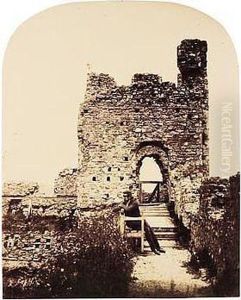Frederick Scott Archer Paintings
Frederick Scott Archer was born on August 18, 1813, in Bishop's Stortford, Hertfordshire, England. He was a sculptor by trade but is most renowned for his significant contributions to the field of photography. Archer's early life and education remain relatively obscure, but it is known that he moved to London in his youth to pursue a career in sculpture.
In the 1840s, photography was still in its nascency, and the available methods such as the Daguerreotype and Calotype had significant limitations. The Daguerreotype produced a single image on a silvered plate, which was not reproducible, while the Calotype produced paper negatives with less detail and sharpness. Seeking an improved process that could yield more precise images and be readily replicated, Archer began experimenting with different chemicals and techniques.
In 1851, Archer published his groundbreaking findings in The Chemist magazine, introducing the wet plate collodion process. This method involved coating a glass plate with a mixture of collodion (a flammable solution of cellulose nitrate in ether and alcohol) and potassium iodide, then sensitizing the plate with silver nitrate. The plate had to be exposed in the camera while still wet and then developed immediately. The resulting negative could be used to produce multiple positive prints on paper. The collodion process significantly reduced exposure times and improved the detail and clarity of the resulting images, revolutionizing the field of photography.
Despite the profound impact of his invention, Archer did not patent the collodion process, altruistically allowing its free use by others. This decision, while noble, led to financial hardship for Archer and his family. He continued to work and innovate in photography, but with little financial gain.
Frederick Scott Archer died impoverished on May 1, 1857, in London. He was only 44 years old. After his death, a memorial fund was established to support his widow and children, acknowledging the value of his contributions to photography. Archer's legacy lived on through the wet plate collodion process, which remained the dominant form of photography for several decades until the advent of dry plate technology. Today, he is remembered as a pivotal figure in the history of photography, whose dedication to his craft led to a significant leap forward in the capabilities and accessibility of photographic imaging.


